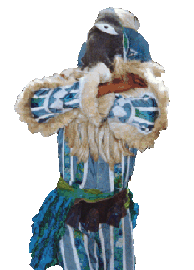I have always thought that the encounter
and the friendship with a “Maestro” was fundamental to get closer,
to find and to learn traditional ancient disciplines and forms of art. The
“Maestro” is the landmark who can teach not only the technical
notions, but can mainly communicate the passion for the whole culture of
a tradition.
When I began to study percussion instruments, I was lucky to find a “Maestro”:
I met and I began to study with Giovanni Imparato that I have always
considered the “Maestro” who showed and opened me the door of
Afro-Cuban musical and rhythmical culture, besides letting me find and understand
the close and indivisible link between the man and the drum.
In my opinion, Afro-Cuban music represents a large field, sometimes contradictory:
a big box rich in deep and intense energies that express through forms of
holy and profane traditions, a world where the more one believes to know,
the more one realizes to be unconscious of many other aspects; a world where
very rigid stylistic and musical rules exist, until when one is able to
change them, since the essence has been understood.
The aspect that more fascinated me in the search of the origins of Afro-Cuban
music was to find the passage of a whole culture, the African one, from
its continent of origin to another, where a large heritage of religions,
dances, songs, rhythms and music instruments were preserved in their archaic
form, until when they developed in something else, enriching themselves
by the encounter with the European culture.
This phenomenon occurred through the deportation of million of African slaves
to America, more specifically to the isle of Cuba, during the colonial period
between XVI and XIX century.
It is not possible to outline in few lines a detailed and complete picture
of the Afro-Cuban music world, but as far as possible I’d like to
frame and to schematize at least the main aspects, as I have tried and I
am trying to do by dedicating myself to deepen this culture.
There are three main stylistic forms in the Cuban music: the Afro–Cuban
folklore, the rumba and the popular music.
The Afro–Cuban folklore includes the dances, the songs and
the rhythms from centre–western
Africa belonging to the religious cults of the African nationalities Yorùba
(or Lucumì), Bantù (or Congo),
Abakuà (or Carabali) and Ararà.
Songs in Africa language, accompanied by the rhythms of ritual drums and
small percussion, are addressed to African gods that rule and determine
human life and every manifestation of nature.
Still today these gods identify themselves with the saints of Catholic religion:
since masters forbade their slaves to practice their own religion because
they feared to suffer evil spells and revolutionary revolts, slaves hid
the practice of their cults faking to pray to Catholic saints to which they
had associated African gods, according to divine powers of both saints.
The rumba is a dance accompanied by rhythms and songs, it is practiced
in the streets and in the courtyards, places where parties take place weekly
and during which participants dance and have fun. The rumba is sung in Spanish
language and it is played with drums called congas or tumbadoras
and small percussion instruments.
Developed in Cuba after the transformation of the African culture into the
Cuban culture, the rumba has the following forms: Yambù,
Guaguancò, Columbia and Giribilla,
according to the character of the dance, of the speed, of the binary or
ternary rhythm and according to the subject of the song. In the last decades,
a new form of rumba, called Guarapachangueo has spread in Havana:
it is a sort of modern guaguancò synthesized by the folk
group Los Chinitos from San Miguel del Padròn that
soon has spread in the town, taking on different forms and variants. As
it happened for the other kinds of rumba, also the guarapachangueo
was initially played only with cajones, that is, wood boxes of
different sizes and sound that took the place of the traditional drums.
Besides the capital Havana, the rumba is also in other cities of Cuba, particularly
in Matanzas, where today there is a large Afro-Cuban community,
due to the high concentration of African slaves that worked in the plantations
of the province. Most of the activities of folklore and Afro-Cuban music
that spread in the island, in America and over the world derive mainly from
these two cities.
The Cuban popular music is an important proof of the fusion of
the African and the European culture.
During the colonial period, a progressive integration of rhythms of drums
and other African percussion instruments and European (mainly Spanish) melodies,
harmonies and instruments happened in Cuba.
Some instruments of the Old Continent underwent a process of transformation,
adapting to musical styles, as the paila (timbales), deriving from
the baroque kettledrums, and the tres, a sort of Spanish guitar
with three double strings.
Son and Danzòn are the original styles of the Cuban
popular music that, from the end of 1800 until today, gave rise to Bolero,
Mambo, Charànga, Cha Cha Cha, Guaràcha, Salsa and Timba.
Another phenomenon of Cuban music which cannot be left out is the Afro–Cuban
Jazz, a mix of melodies, jazz improvisation and rhythm that originated
in the 1940s in the Barrio Latino in New York City thanks to Cuban
musicians influenced by jazz. Mambo orchestras led by Mario Bauzà,
Chano Pozo, Machito, Perez Prado started to talk musically with the
Afro–American style of musicians and conductors such as Dizzie
Gillespie and Stan Kenton. A new, overwhelming and irresistible
musical trend, at first only to dance and subsequently also to listen to,
spread and arrived also at Cuba, where, during the following decades, a
school of Cuban musicians between rumba, popular music and jazz settled;
in the last fifty years these musicians have preserved, developed and spread
this fascinating musical style.

